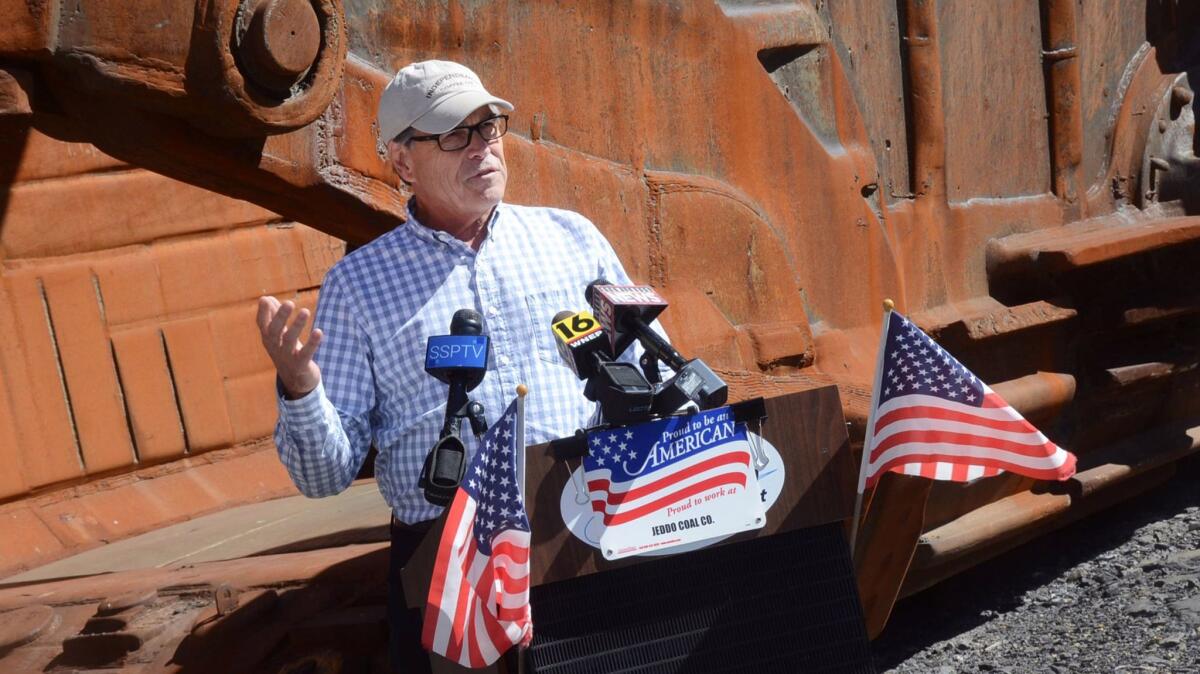Op-Ed: Rick Perry’s plan to subsidize coal and nuclear plants does nothing to fix the U.S. power grid

- Share via
Energy Secretary Rick Perry proposed a rule last week that would require electricity customers to subsidize coal and nuclear power plants that can demonstrate “fuel security,” which the rule defines as 90 days’ worth of stockpiled fuel that could be used to generate electricity in the event of a disruption. The Department of Energy claims it proposed this rule in order to improve the resilience of the electric power grid — its ability to adapt to changing conditions and recover from problems.
This is a worthy goal, of course. The country’s grid is vulnerable to many threats. Hurricanes Harvey, Irma and Maria demonstrated what happens when power grids do not have built-in resilience. Next to extreme weather, the most common cause of outages is squirrels. Less likely but potentially more damaging are a host of other threats — cyber attacks, physical attacks, the detonation of a nuclear weapon, natural solar storms. Under the right circumstances, any one of these scenarios could bring down large portions of the grid for months and cost trillions.
But stockpiling coal or uranium would not mitigate these threats. Nor would Perry’s rule improve the long-term resilience of America’s energy grid, because it fails to address its single biggest point of weakness: the grid itself.
Virtually all threats to the U.S. power grid manifest in the transmission and distribution system — the delicate network of wires that transports energy hundreds of miles from large, centralized power plants to our homes and businesses. A truly safe, modern grid would connect centralized power plants with more distributed micro-grids, which can work together or, if necessary, be easily isolated from one another. Smaller, more agile grids could also be designed to even fix themselves in an emergency by rerouting power away from disrupted areas.
Any serious attempt to improve the country’s energy resilience needs to take advantage of emerging solutions rather than prop up 20th-century ones.
The U.S. military understands this. To ensure national security, it has sought to improve its energy resilience in a variety of ways, one of them microgrids. The Air Force, Army, Navy and Marines are also increasing their use of renewable energy, recognizing that, though enemies of the U.S. could conceivably disrupt access to stockpiled coal or diesel, they are unable to shut off the wind or sun. They also make full use of local energy sources, spreading out the burdens of both electricity generation and demand. The Marine Corps Air Station Miramar does this, as do the Otis Air National Guard Base and the Ft. Hood Army base in Texas.
It’s not just the military. Communities as varied as Borrego Springs, Calif., Sterling, Mass., and North Carolina’s Ocracoke Island have reaped the benefits of renewable-powered microgrids.
In many cases it’s cheaper for utility companies to build wind and solar power plants than it is for them to run existing coal and nuclear power plants, and these technologies can now be easily integrated into the U.S. grid without producing negative effects on its reliability. California, for instance, procures none of its electricity from in-state coal, will soon shut down its last nuclear power plant and is steadily increasing the state’s reliance on wind and solar.
Although the recent spate of extreme storms demonstrated the need for grid resilience, in some areas they also showed the considerable benefits of renewable energy: Texas wind farms withstood Harvey, and solar-powered homes in Florida had electricity during Irma.
Perry’s rule takes none of this into account. It ignores the potential of renewables to vastly improve the resilience of the U.S. power grid. It also ignores the clear message from the country’s wholesale electricity markets — and from the utilities themselves — that many existing coal and nuclear power plants are simply uncompetitive in the dawning era of cheap natural gas and renewables.
Instead, Perry’s rule would hand a massive bailout to outdated power plants. It is also a solution in search of a problem: There is no evidence that a lack of on-site fuel at coal and nuclear power plants has led to any significant service outages in the U.S. in recent decades.
Worse, the rule could actually lessen the grid’s resilience by further centralizing crucial power resources in fewer and more concentrated locations — sitting ducks for disruption.
Perry’s proposed rule looks backward, not forward. Any serious attempt to improve the country’s energy resilience needs to take advantage of emerging solutions rather than prop up 20th-century ones.
Miranda A.A. Ballentine is a managing director at Rocky Mountain Institute, a sustainable-energy research group. She served as assistant secretary of the Air Force from 2014 to 2017. Mark Dyson is a principal with Rocky Mountain Institute’s electricity practice.
Follow the Opinion section on Twitter @latimesopinion or Facebook
More to Read
A cure for the common opinion
Get thought-provoking perspectives with our weekly newsletter.
You may occasionally receive promotional content from the Los Angeles Times.









